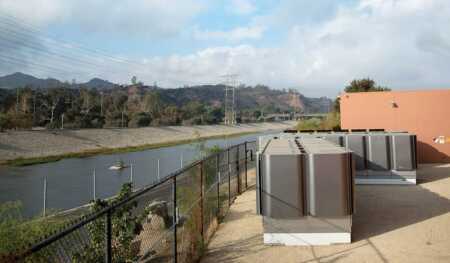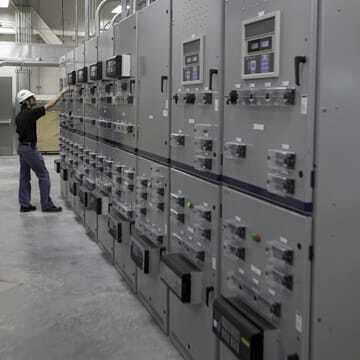
One type of microgrid technology is a fuel cell, such as this Bloom Energy Server at the six-acre (2.4 ha) DreamWorks SKG animation headquarters in Glendale, California. Fuel cells power the campus by converting fuel into electricity through an electrochemical process that is cleaner than thermal combustion. (Bloom Energy)
Power reliability is becoming an increasingly important consideration in real estate development, and that is causing some property owners and managers to seek more stable and secure power systems such as microgrids—self-sustaining power generation systems that are connected to the traditional utility power grid but which are capable of running independently from it when necessary.
Some homes and businesses already have backup generators to cover power outages, but microgrids differ from those backup systems in their ability to provide uninterrupted power. Also, because microgrids are often developed with renewable energy sources such as solar or fuel cells, they can offer greater flexibility, energy efficiency, and cost savings compared with those offered by the traditional utility grid or backup generators, which typically are powered by diesel fuel.
“The idea of producing your own power and doing it more cleanly is more attractive to a lot of businesses and institutions today,” says Andrew Mulherkar, a power grid analyst with GTM Research, an alternative-energy information company that researched the North American microgrid market in 2014. “This is catching on.”
The largest private real estate project in the United States, the 17 million-square-foot (1.6 million sq m) Hudson Yards project under construction in New York City, is among the newer developments planning to incorporate a microgrid, which will eventually power its first three buildings. If another Superstorm Sandy hits the East Coast—or if any storm blows down power lines and causes a power outage—it will not affect the electricity supply to Hudson Yards.
“We want Hudson Yards to represent what a 21st-century neighborhood should be, which is efficient, resilient, reliable, and constantly connected,” says Charlotte Matthew, vice president of sustainability for the Related Companies, the project’s developer along with Oxford Properties Group. “We want a large-enough system on site in case the grid goes out, so we can keep Hudson Yards sort of a beacon of New York City.”
Historically, microgrids had been used as a power supply only for remote communities, such as island populations. But in the past few years, some institutions that need uninterrupted power, such as military facilities, public-safety operations, and health systems, have been adding microgrids, and their use is expanding to commercial offices, industrial facilities, and grocery stores.
GTM Research forecasts that microgrid investments, while still small compared with other power sources, could jump fivefold—from $133 million to $671 million—from 2014 to 2017. Another research firm, Navigant Consulting, foresees microgrid power generation in North America soaring fivefold (in terms of megawatts) from 2013 to 2020.
This growing interest is driven by fears of power outages caused by extreme weather along with the increasing attractiveness of renewable systems because of falling prices for solar and battery storage solutions. The number of reported U.S. power outages in 2013—the latest year for which data are available—reached a record 3,236, or more than 60 every week across the country, according to a blackout tracking list compiled by Eaton Corporation, a power-management products company.
When blackouts hit the University of Florida’s Shands Hospital in recent years, it was ready. The academic medical center in Gainesville was built in 2009, and the university wanted it to have more than the traditional backup power supply. So the hospital campus was developed with a $45 million microgrid that is connected to the utility grid, but it can isolate itself from the grid whenever necessary. The grid went down on two occasions, and on both the microgrid automatically took over with just a flickering of the hospital’s lights. “The occupants of the hospital didn’t even notice it,” says Brad Pollitt, vice president of facilities for Shands. “Every outlet stayed on, and that’s what you need.”
Power Hazards

The University of Florida Health’s Shands Hospital, a gas-fired turbine generator is connected to the local utility grid to power the facility. If the utility grid fails, the generator automatically switches to a microgrid “island mode” that can power the facility on its own. (University of Florida Health)
In 2013, the federal government issued a report that estimated that outages caused by harsh weather alone cost the U.S. economy $18 billion to $33 billion a year. In that year, according to Eaton’s blackout tracking list, the average power outage affected 6,500 people, with California, Texas, and Michigan the hardest-hit states. Since Eaton began tracking power outages in 2009, the annual number in the United States has increased 14 percent.
In response to these increasing disruptions and growing concerns about cyber security, the U.S. Department of Energy partnered with several federal agencies to create the Smart Power Infrastructure Demonstration and Energy Reliability and Security (SPIDERS) project with microgrids at military sites. SPIDERS is a three-year, $40 million, multiagency initiative to develop fully functioning microgrids—in which critical loads could be maintained for at least three days—at three military facilities in the United States in case a cyber attack shuts down the grid. The last of the three systems is scheduled to be completed in 2015.
In addition, the East Coast states of Connecticut, Maryland, Massachusetts, New York, and New Jersey have launched microgrid funding programs or demonstration projects in the last couple of years. In 2014, New Jersey created a $200 million infrastructure bank focused on energy-resilience projects such as microgrids at public facilities.
“When there are prolonged outages, there’s a breakdown in the social fabric. People can’t get to the pharmacy for medicines or to the grocery store or to the bank,” says Abigail Ross Hopper, the director of the Maryland Energy Administration who headed a state task force last year that recommended policy changes to promote microgrids. “We are interested in how to keep the social fabric intact.”
Microgrids, though, are still in the early development stage. GTM Research compiled the first-known comprehensive list of microgrids and found fewer than 100 systems currently in operation across the United States. More than half of the installations have been at universities and military facilities. There are microgrids at the University of California–San Diego, Michigan State University, and Princeton University in New Jersey, to name a few. And the U.S. Department of Defense has installed demonstration projects at Eielson Air Force Base in Alaska, Robins Air Force Base in Georgia, and Fort Bragg in North Carolina, among other facilities.
But the small numbers mask the growth trajectory. Most of today’s microgrids have been installed just since 2011, prompting GTM Research to observe the following: “The increased number of project initiations in the past three years is a harbinger of faster long-term growth.” Indeed, based on current proposals and plans, the number of microgrids in the United States could double in the next few years.
Though universities and the military continue to be the leading adopters, microgrid projects are beginning to make inroads into local government institutions and commercial real estate developments. The Connecticut town of Woodbridge, for example, is creating a microgrid to power its police and fire stations, town hall, and high school. New York City is building a microgrid at its Rikers Island jail complex. And New Jersey Transit has received a federal grant of $410 million to develop a giant microgrid for its entire rail system.
In real estate, property developers have started experimenting with microgrids in select office buildings, and microgrid developers have seen burgeoning interest from commercial properties with large electricity appetites, such as data centers, industrial warehouses, and big-box retailers.
“They have begun to understand that they face an open-ended risk by relying on the grid,” says Asim Hussain, senior marketing director of Bloom Energy, a California-based power generation technology company specializing in fuel cell–microgrid systems. “They have very little control over their electricity rates, and they’re increasingly exposed to reliability risks. They want alternatives.”
In Laurel, Maryland, a suburb northeast of Washington, D.C., Konterra Realty has been developing a 2,000-acre (809 ha) mixed-use residential/office project. When Konterra planned its first office building, a consulting partner suggested combining solar power with a microgrid. “We really didn’t know what that was,” recalls Rich McCoy, a Konterra executive vice president. Konterra was persuaded to try it because of the promise of sustainable power. So its six-story, 125,000-square-foot (11,600 sq m) building, completed in 2013, included a solar-covered parking lot connected to a microgrid. The $2.5 million microgrid provides about 20 percent of the building’s power on a daily basis but can keep critical systems operating if the utility grid goes down.
“It’s cutting-edge, and we like to be an early adopter,” McCoy says. “It’s appealing that we can be off the grid if need be and still function.”
Building Momentum
Superstorm Sandy serves as the poster child for the appeal and benefit of stable, uninterrupted power. While that storm in 2012 caused power outages for 10 million utility customers in 24 states from Maine to Florida, an emergency shelter at South Windsor High School in South Windsor, Connecticut, was powered by a microgrid. In addition, Princeton University was able to stay powered up and serve hot meals for two and a half days until utility power was restored. And at a New York City housing cooperative called Co-op City, its self-contained central plant was able to keep the lights on for 60,000 residents in dozens of high-rise buildings and townhouse clusters.
But reliability is hardly the only advantage of a microgrid. More than half of all planned microgrids are expected to incorporate solar power, which promises more energy efficiency than a typical building power system. Plus, many microgrids include the ability to sell excess electricity back to the utility grid, which can reduce a facility’s utility bill. For instance, Princeton’s microgrid draws electricity from the utility grid at night, when kilowatts are priced lower. Then it stores that power to use at its research laboratories and dining halls during the day. This process has resulted in a 10 to 15 percent savings in the university’s energy bill, according to GTM Research.
Still, the growth of microgrids faces a few challenges. One is cost. GTM Research found that projects typically cost between $1,000 and $4,700 per kilowatt, usually adding up to several million dollars for any system larger than one megawatt. Moreover, the return on investment can take a decade or more. For instance, power systems software developer ETAP Corporation built its own microgrid plant for $1.1 million in 2013, and, by the company’s estimate, the anticipated energy savings could lead to a 15-year payback period.
As a consultant report for the Massachusetts Clean Energy Center explained in 2014: “Developing a compelling business case for a microgrid can be a significant challenge.”
Then there is the tricky issue of utility regulations. In many states, utility franchise rights question or limit the ability of nonutilities to operate power-generating systems and transmission lines serving more than one facility or customer.
Microgrid proponents, though, are optimistic that momentum is on their side.
Some regulatory frameworks are starting to evolve in ways that support commercial projects. Maryland Energy Administration’s Abigail Ross Hopper, for one, notes that “there are a lot of statutory pieces, but none of them are insurmountable. I think there’s political will because consumers are demanding more [power] reliability.”
Also, the microgrid industry is beginning to develop financing packages to make projects more affordable. Types of financing structures include power-purchase agreements, in which an outside third-party vendor finances and owns the power system, and performance contracting, in which there are no upfront costs to the facility and the financing is based on anticipated energy cost savings. A normal microgrid project involves collaborations with five or more funders and technology partners, according to GTM Research. For instance, San Diego Gas & Electric’s five-megawatt microgrid for the small California community of Borrego Springs cost $15.2 million, with the utility paying half and the other half coming from the U.S. Department of Energy and a half-dozen private sources.
“The trick is: how do you make the numbers work?” says Tom Leyden, chief executive officer of Philadelphia-based Solar Grid Storage, one of the new crop of companies developing commercial microgrid systems. “The industry is innovating and creating financial models to address this.”
The bottom line: The microgrid market is still in its infancy. It is such a new concept in commercial real estate that property managers do not know yet how to value it—that is, how to use a microgrid as a selling point or incorporate it into rents. Yet, at many properties that have installed microgrids, the real estate executives swear by them.
At a master-planned community called Mesa del Sol in Albuquerque, New Mexico, a microgrid was incorporated in its first commercial building, the 78,000-square-foot (7,250 sq m) office/retail Aperture Center. It was a marriage of happenstance—Mesa del Sol wanted to set an example as a sustainable development, and it was approached by Japan’s New Energy and Industrial Technology Development Organization, which was looking for a demonstration project in the United States. The result was a $22 million solar- and natural gas–fueled project that involved more than a dozen local, state, and Japanese partners. Now it powers almost one-third of the building on most days, and kept the lights on after one severe storm knocked out electricity from the utility.
“It’s been an amazing project,” says Manny Barrera, Mesa del Sol’s director of development. “It’s aligned with our ethos of pushing the envelope for sustainability and smart growth.







